Batelle Darby Metro Park
We went on Wednesday to explore the Batelle Darby metro park. Supplemental reading was provided in the form of Jane Forsyth’s article Linking Geology and Botany…a new approach in which she discusses in length Ohio’s landscape and how it relates to and affects the development of plants across the state. Below are some of the key points to take away from the article:
Key Points:
- The western part of Ohio is composed of limestone and dolomite which are typically nonresistant in this humid climate. Due to millions of years of eroding this part of Ohio has been worn down to flat land. The eastern part of Ohio is made up of sandstone which is a resistant rock and shale which is no resistant. As a result erosion in the east has only succeeded in carving out deep valleys forming steep sided sandstone hills or sandstone capped hills in the Cleveland area.
- Originally Ohio lied on 3 layers of sedimentary rock strata in the order with limestone being the bottom layer, above that shale, and then finally on top being sandstone which formed a gentle arch before erosion began. The crest of this arch which is the most weathered away part with exposed limestone was present on the western part of the state extending south to north. The bottom of the arch was located further east where the sandstone remains partially weathered but not completely gone typical of the hills in Cleveland area. Most of the weathering in the west and east was accomplished due to the Teays river which was present for what is believed to be 200 million years only to be curtailed by the advancing glaciers of the ice age.
- Originally the steep sided sandstone hills of eastern Ohio slowed down the glacial advance so there isn’t a glacial boundary any further than Canton, on the west however there was nothing to stop the glacial advance and it extends down into Kentucky. A sketch of which has been provided. Ohio-map.pdf
- A till is an unsorted mixture of sand, silt, clay, and boulders deposited by a glacier when it melts. The till accumulates materials as it moves over other rock types. So in western Ohio the till deposits were mostly limestone and clay but due to the hills there isn’t much limestone or clay.
- Western basic substrate the soil is relatively impermeable making it so it doesn’t drain well or have very good aeration, it is however high in lime. This creates low oxygen availability during wet periods and bad droughts during dry spells. The amount of nutrients available here are considered abundant. The eastern basic substrate is very permeable but it produces very acidic low nutrient substrate which is especially dry on the top of hills and is low in lime. Sandstone and shale both create acidic environments the former is very permeable whilst the latter is not at all.
- Five plants that are generally limited to limestone or limey substrates like Lake Erie’s islands are: redbud, red cedar, fragrant sumac, hackberry, and blue ash.
- Five plants that are generally limited to high lime clay rich substrates like the thick glacial tills of western Ohio are: sugar maple, beech, red oak, shagbark hickory, and white oak.
- Five plants that are generally limited to sandstone hills of eastern Ohio are: chestnut oak, sourwood, scrub pine, pitch pine, and hemlock.
-
Sweet buckeye is present in unglaciated areas in Ohio which lie in the eastern hills. The soils it needs to grow are fairly abundant and extend well into the northern part of the state but yet it doesn’t grow there. It is believed to be a repopulation problem where there may be a climate controlling factor that is affecting the growth. Hemlock is more abundant in a lot of the same areas are buckeye but it is due to the cool climate that it is able to extend to parts of the state that the buckeye cannot. Hemlock grows in lowlands with lots of cool water with sandstone and can even grow in less acidic conditions if need be. Rhododendron distribution was believed to be determined by the position of the ancient Teays river which ran through Ohio. The plants grew best in the valleys where the river ran through, but subsequent glacial advances wiped out the river. Most valleys were destroyed but these plants however remained.
The Field Trip Itself
Upon arrival we went right ahead and identified the plants to keep an eye out for. The goal was to find 4 limestone loving plants, 2 invasive species, and 2 specially assigned plants to document and upload on our page. My special 2 plants were 2 plants with opposite leaves. Below are the plants I documented.
Starting off with the invasive species firstly we have Amur Honeysuckle, Lonicera maackii. It is native to temperate Eastern Asia but was introduced to reduce erosion but quickly escaped and began running wild. It has many competitive advantages to native Ohio plants including longer growing season, adaptability to soil and shade, fast growth, and finally the leaves, roots, and fruits all exude chemicals to reduce germination of native species. Fun fact the berries produced are mildly poisonous to humans and can cause sever diarrhea.
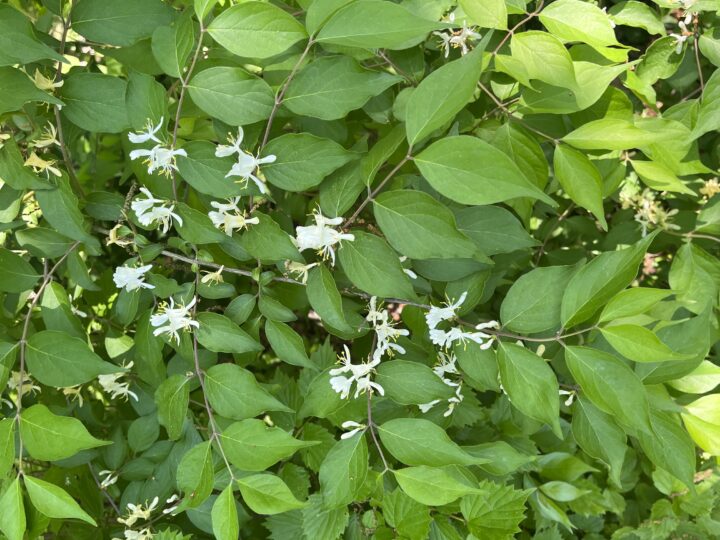
Amur Honey Suckle invasive species
The other invasive species we saw was Garlic Mustard, Alliaria petiolata. It is native to Europe and Western Asia and Africa. Believed to be introduced to the states for medicinal and food purposes. It’s competitive advantage is that it emerges much faster than native plants so by the time other plants are ready to grow garlic mustard has blocked out all its sunlight. Fun fact it was given its name because its leaves have a garlic smell when they are crushed.
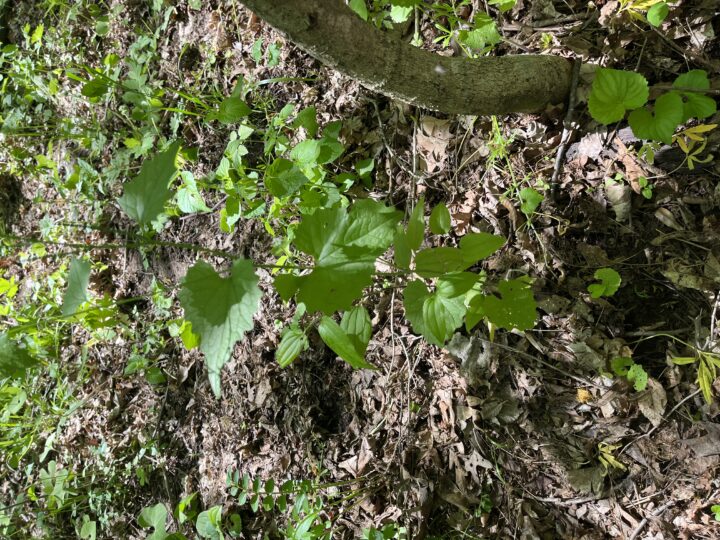
Garlic Mustard invasive species
Now that we have got those two invasive species out of the way we can get into the 4 limestone loving plants that we saw on our trip. First up is American Hackberry, Celtis occidentalis. It is indeed a calciphile with leaves that are toothed, corky bark with warts, and orange-red to dark purple fruits that are produced. Fun fact they are often used as ornamentals because they are drought resistant.
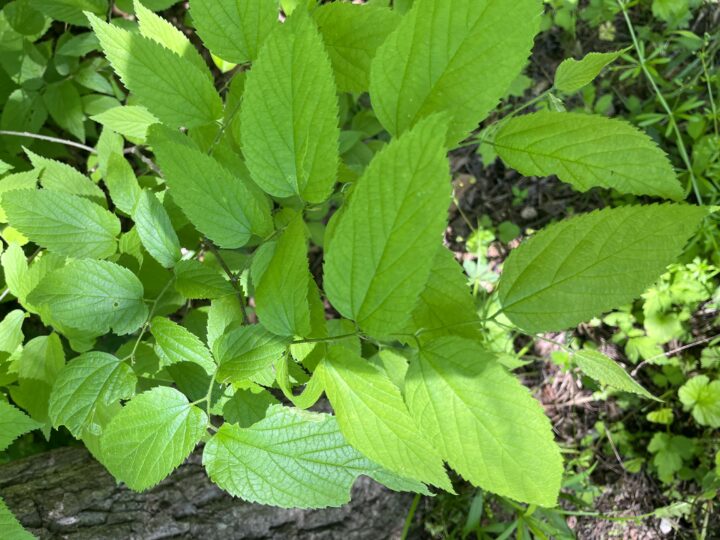
American Hackberry calciphile
Next up is Blue Ash, Fraxinus quadrangulata. Also a well known calciphile with branches and twigs being boxy or square shaped, leaves are opposite in usually 7 leaflets that have distinct margins on the leaf, flowers are small and purple and fruits are samaras. Fun fact there is a city in Ohio called Blue Ash.
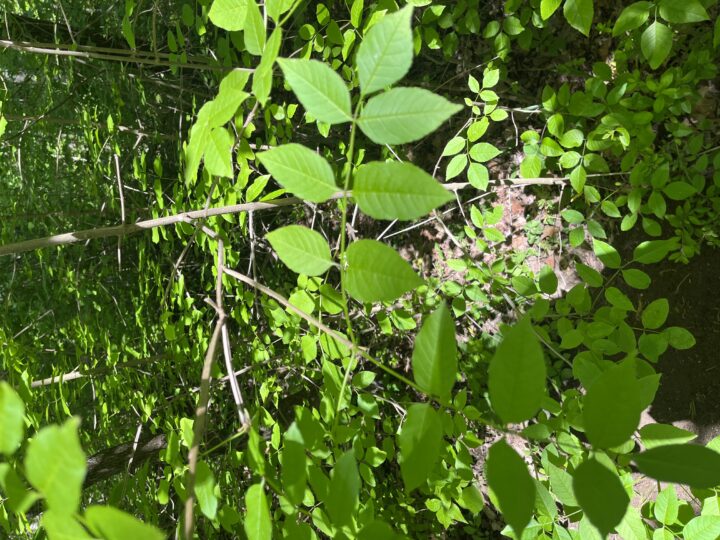
Blue Ash calciphile
Following that is Chinquapin Oak, Quercus muehlenbergii. You guessed it a calciphile with glossy and coarsely toothed leaves that are considered small for Oaks. The Chinquapin Oak produces Acorns with no stems that half is enclosed by a thin cup and is chestnut brown or even black. Fun fact Cherokee Indians used the dry leaves for medicinal purposes like fevers and headaches.

Chinquapin Oak calciphile
The last of the Limestone lovers we saw was Fragrant Sumac, Rhus aromatica. This is the last of the calciphiles spotted on our trip. It has velvety twigs, coarsely toothed trifoliate leaves, with yellow flowers that make way for dark red berries. The leaves on this plant when crushed smell lemony. Fun Fact the leaves were mixed with tobacco to make a smoking mixture.
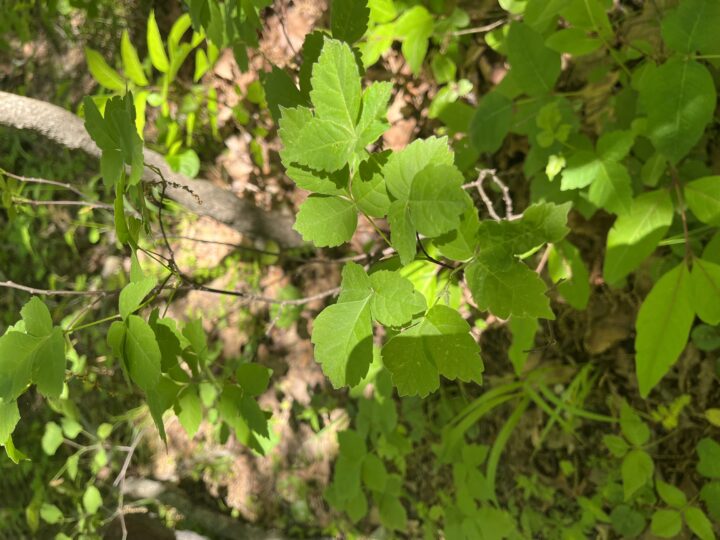
Fragrant Sumac calciphile
Finally comes my individual assignment which was find two plants with opposite leaves. The first one I was able to find was the Ohio Buckeye, Aesculus glabra. This tree had palmately compound leaves with five leaflets. The leaves themselves had a wavy texture to them and when a branch was broken it gave off a distinctly skunky smell. They give rise to red and yellow-green flowers which develop into what we call buckeyes. Fun fact we call them buckeyes because the nuts resemble the eye of a deer.
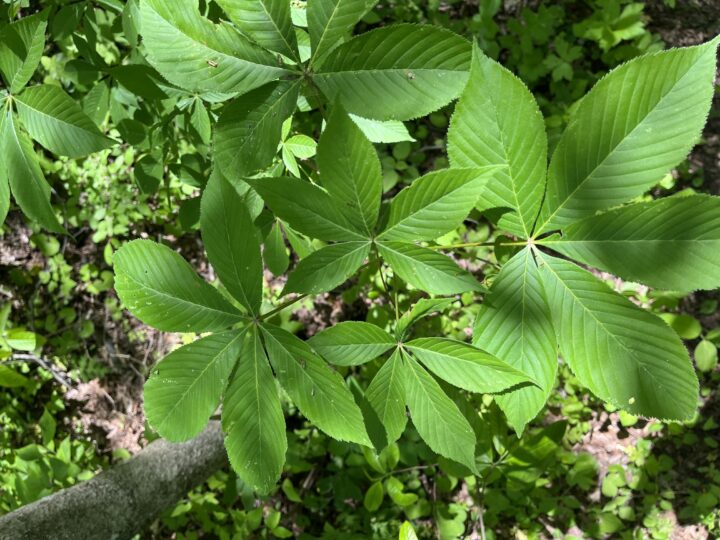
Ohio Buckeye opposite leaves
The other opposite leaved plant we saw was a Norway Maple, Acer platanoides. These trees are native to Eastern and Central Europe, as well as, Scandinavia, Iran, and Western Asia. It was believed to have been introduced to North America as a shade tree and they are very tolerant of many different growing environments. The leaves have 5 lobes and usually they appear well before other maples. The flowers are yellowish clusters that give rise to paired samaras. Fun fact Stradivarius violins are said to be made of Norway maple.

Norway Maple opposite leaves
